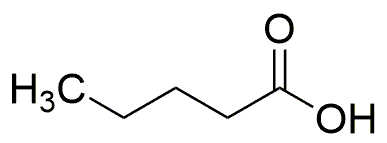Valeric acid is widely utilized in research focused on:
- Flavoring and Fragrance Industry: This compound is used as a flavoring agent in food products and as a fragrance in perfumes and cosmetics, providing a distinctive scent and taste that enhances consumer appeal.
- Pharmaceuticals: Valeric acid serves as a building block in the synthesis of various pharmaceuticals, including sedatives and anti-anxiety medications, due to its calming properties.
- Biochemical Research: In laboratories, it is used to study metabolic pathways and cellular processes, aiding researchers in understanding biological functions and developing new treatments.
- Industrial Applications: It is utilized in the production of esters for plastics and resins, contributing to the manufacturing of durable materials used in everyday products.
- Agriculture: Valeric acid is applied in the formulation of herbicides and pesticides, helping to improve crop yields while minimizing environmental impact.
General Information
Properties
Safety and Regulations
Applications
Valeric acid is widely utilized in research focused on:
- Flavoring and Fragrance Industry: This compound is used as a flavoring agent in food products and as a fragrance in perfumes and cosmetics, providing a distinctive scent and taste that enhances consumer appeal.
- Pharmaceuticals: Valeric acid serves as a building block in the synthesis of various pharmaceuticals, including sedatives and anti-anxiety medications, due to its calming properties.
- Biochemical Research: In laboratories, it is used to study metabolic pathways and cellular processes, aiding researchers in understanding biological functions and developing new treatments.
- Industrial Applications: It is utilized in the production of esters for plastics and resins, contributing to the manufacturing of durable materials used in everyday products.
- Agriculture: Valeric acid is applied in the formulation of herbicides and pesticides, helping to improve crop yields while minimizing environmental impact.
Documents
Safety Data Sheets (SDS)
The SDS provides comprehensive safety information on handling, storage, and disposal of the product.
Product Specification (PS)
The PS provides a comprehensive breakdown of the product’s properties, including chemical composition, physical state, purity, and storage requirements. It also details acceptable quality ranges and the product's intended applications.
Certificates of Analysis (COA)
Search for Certificates of Analysis (COA) by entering the products Lot Number. Lot and Batch Numbers can be found on a product’s label following the words ‘Lot’ or ‘Batch’.
*Catalog Number
*Lot Number
Certificates Of Origin (COO)
This COO confirms the country where the product was manufactured, and also details the materials and components used in it and whether it is derived from natural, synthetic, or other specific sources. This certificate may be required for customs, trade, and regulatory compliance.
*Catalog Number
*Lot Number
Safety Data Sheets (SDS)
The SDS provides comprehensive safety information on handling, storage, and disposal of the product.
DownloadProduct Specification (PS)
The PS provides a comprehensive breakdown of the product’s properties, including chemical composition, physical state, purity, and storage requirements. It also details acceptable quality ranges and the product's intended applications.
DownloadCertificates of Analysis (COA)
Search for Certificates of Analysis (COA) by entering the products Lot Number. Lot and Batch Numbers can be found on a product’s label following the words ‘Lot’ or ‘Batch’.
*Catalog Number
*Lot Number
Certificates Of Origin (COO)
This COO confirms the country where the product was manufactured, and also details the materials and components used in it and whether it is derived from natural, synthetic, or other specific sources. This certificate may be required for customs, trade, and regulatory compliance.

